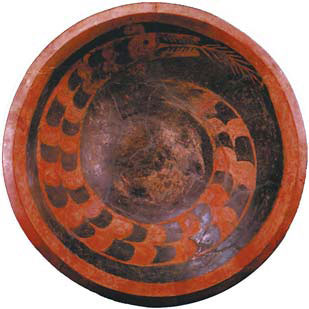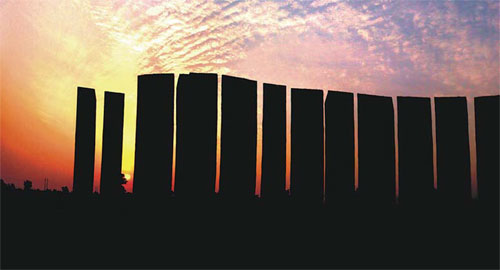Humble fields belie millennia of history at Taosi relics site
Editor's note: The Xiangfen county government has applied to the State Administration of Cultural Heritage for permission to build a national-level archaeological park on the Taosi ancient relics site.
Of all the places we visited in Shanxi, the one that made the biggest impression on me was the Taosi relics site. Who would have thought that a civilization that flourished thousands of years ago would lie beneath this province known for its coal production?
We stumbled off the bus to a formal welcome of several uniformed police officers standing to attention beside four electric golf carts. A wooden sign beside the road informed us in fresh gold characters that we were there to visit Taosi, or the clay temple. Looking around, we saw no temples but were surrounded by farmland sparsely interspersed by houses.
With only the sound of our chatter and the quiet whirring of the electric vehicles, we set off down the road between fields of faded greenery and cornhusks and arrived at a nondescript building where a woman stood wearing a microphone.
That is when things got interesting.
At the insistence of our guide, we went inside the dark building, wondering why we were there, and gathered around a model of tiny brown houses surrounded by shrubbery that resembled the dullness of the scenery outside, despite a string of LED lights. It was a model of the Taosi site, with labels marking the residential area of the nobility, the residential area of the commoners and the location of the observatory.
The simple model represents the site that some archaeologists argue was the capital of the legendary Emperor Yao, a mythical figure who most scholars believe to be fictional. According to Confucian texts, Yao was one of the sage emperors, a group of mythological rulers who existed before the Xia, commonly accepted as the first Chinese dynasty. The texts extol the virtues of these sage kings, who were supposed to have been paragons of benevolence and moral fiber.
The Taosi site has been dated to around 2300 BC. Where now stand fields being farmed manually with basic tools, it was easy to imagine a city rising out of the soil 4,300 years ago, its inhabitants building a city wall out of rammed earth and using the observatory to keep track of the seasons.
Today, the observatory is perhaps the most impressive experience on the site. Pillars that stand several meters tall were built directly on top of the original earthen ones (which were quite a bit shorter). Viewers can stand on the observation point, where they can see the sun shining through the pillars when it rises from behind Chongshan, the mountain located behind the structure. Our visit was on Sept. 23, around the time of the autumn equinox, so we would have observed the sun rising through the seventh slot if we'd been there at sunrise.
The Taosi civilization was a fairly sophisticated society. There was a small group of elites controlling a large lower class, with a wall separating their living areas. Remains of the royal palace, the king's tomb, ceremonial areas and craft-production areas have been unearthed, and the city wall would have required considerable organization to build.
To put the Taosi culture in context, around its time the Minoans had not yet built their palaces, but had large towns and traded with other peoples across the sea. They had a lack of centralized authority and round tombs housing entire villages or clans, while the Egyptians already had the organizational capability to build the first pyramids.
We experienced Taosi's fascinating culture through a few artifacts in the museum, photographs of the excavated graves, a 20-minute video in Chinese, and the reconstructed observatory site, so it required a bit of filling in with our imaginations. The guide explained that the archaeologists had to rebury most of the Taosi site until they had enough resources and funding to study it thoroughly.
The Taosi site has been part of the eleven-year "Retracing Chinese Civilization Project" funded by the Chinese government from 2004-2015 and, for Chinese scholars, it is a crucial piece of the puzzle when it comes to tracing the beginning of China as a state.
The author is a reporter from Canada.
catherine.hs.lai@gmail.com
|
A color pottery plate with dragon pattern excavated at the Taosi ancient relics site. |
|
An ancient observatory at the Taosi ancient relics site dates back to around 2300 BC. Photos provided to China Daily |
(China Daily 10/22/2015 page6)




















